Cannara Festa della Cipolla (Onion Festival) Read more
The small town of Cannara, my temporary home during my 3 month Italian sojourn, is undeniably small. And this is a great thing! ...
Was it too much food? Absolutely. Do I regret eating any of it? Not one bite.
We are here with our Food & Wine Tour group to Discover, Savor and Share – to explore the foods and wines of Umbria. It’s not possible to shape the experience without enjoying a few extra bites. We have six full days to discover hundreds of years of traditions. To enjoy a meal around the table – not standing at the bar eating a sandwich. For Americans, relaxing over a meal can be a challenge. To linger over two meals a day can be excruciating.
In the states we multi-task our way through a meal. Sitting at our desk with a phone in one hand and a sandwich in the other. Grabbing a bite to eat and a cup of coffee or a bottle of water every time we get into the car. Italians enjoy a small coffee at the bar and if they want more they make an additional stop. The idea of eating in the car is foreign. Their cars are not littered with fast food wrappers. Their children don’t eat foods that are non-spillable so that they can eat on the go. When I’m in Italy it all makes sense. When I’m back in the states I’m the one biting into an egg sandwich as I speed down I-95 at 70+ miles per hour – only to have the perfectly cooked yolk explode all over me and over the windshield. So much for multitasking and freeing up my time. Should have spent 15 minutes sitting down and relishing my breakfast instead of half an hour detailing the car.
We spend our week in Italy enjoying many meals together with new friends. Our most over the top, I-can-never-eat-another-bite-again day is at Ristorante Perbacco with our friend Ernesto. He has designed a 14 course tasting menu (sometimes more but never less) for us to cook together and to enjoy together. Starting with a main course and working backwards to dessert the fun never ends. We spend our day making dough that can be transformed into fried bread, baked bread or even pasta. Making pasta dough and turning it into five different shapes, each needing a separate sauce to showcase it. And most of all we relax and we laugh together. We are creating so many different foods that we don’t need to worry about precision and as a result everything turns out perfectly. So we pour a prosecco, take off our aprons and toast to another successful adventure together before we sit down and eat.
If I had to take out a few bites – where would I begin? I would begin at home – never in Italy.
Finding the Right Balance in Italy Read more
Was it too much food? Absolutely. Do I regret eating any of it? Not one bite. We are here with our Food & ...
I know this might shock you, but I love food and I love to eat out. However, my least favorite trend at restaurants (aside from sharing plates that come in all shapes and sizes) is ordering my food to have it come out of the kitchen as it is ready.
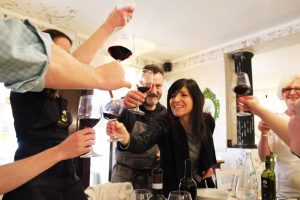 No rhyme or reason, no order of preparation, just a random delivery of food. So depending on what is happening in the kitchen – if the pasta line is backed up and the fish station is slow you may get your main course before your pasta. Roasted olives intended to be a starter show up right before dessert. Who knows what will be served with my cocktail. With this convoluted method it’s not possible to pair a wine with each course. As we know, one of the biggest challenges in any kitchen is timing; timing is everything, it takes a talented chef to prepare a variety of plates for each table that are ready to be served together. There is a constant distraction from what is being served when the food comes on a whim and the plates are meant to be shared. It is natural to focus more on the passing and making sure things are divided equally, but that interrupts the experience the dish is meant to give. Randomly putting plates of food on a table is not a sign of creativity – this should not continue as a trend and we should not be rewarding disorganization and laziness.
No rhyme or reason, no order of preparation, just a random delivery of food. So depending on what is happening in the kitchen – if the pasta line is backed up and the fish station is slow you may get your main course before your pasta. Roasted olives intended to be a starter show up right before dessert. Who knows what will be served with my cocktail. With this convoluted method it’s not possible to pair a wine with each course. As we know, one of the biggest challenges in any kitchen is timing; timing is everything, it takes a talented chef to prepare a variety of plates for each table that are ready to be served together. There is a constant distraction from what is being served when the food comes on a whim and the plates are meant to be shared. It is natural to focus more on the passing and making sure things are divided equally, but that interrupts the experience the dish is meant to give. Randomly putting plates of food on a table is not a sign of creativity – this should not continue as a trend and we should not be rewarding disorganization and laziness.
Cooking with Ernesto is a unique experience, like no other. 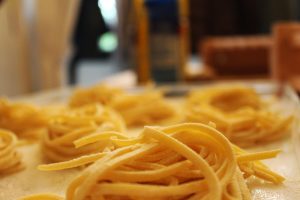 And while for some a day spent cooking with him can be overwhelming and daunting – for me, it is an exciting and endearing adventure. Not one recipe at a time start to finish, rather many pots on the fire: pasta being rolled out, sauces simmering on the stove, meat roasting in the oven and cookies and cakes baking. Now this is the way I love to cook!
And while for some a day spent cooking with him can be overwhelming and daunting – for me, it is an exciting and endearing adventure. Not one recipe at a time start to finish, rather many pots on the fire: pasta being rolled out, sauces simmering on the stove, meat roasting in the oven and cookies and cakes baking. Now this is the way I love to cook!
In this experience, Ernesto teaches us that multitasking is how to accomplish the full menu. To start you have to create a plan, nothing happens in his kitchen without a lot of thought going into it. To execute your plan, you have to pace yourself and not over complicate what you are doing. Think ahead and save time – dice the celery, carrots and onion (sofrito) at once and use it over and over again for different recipes. Make the bread dough at the beginning so it has time to rise before being baked or fried. Make one pasta dough but create different pasta shapes for different dishes.
Ernesto also teaches us that making pasta by hand is fun and easy. My advice is start out small – make pasta for one or two 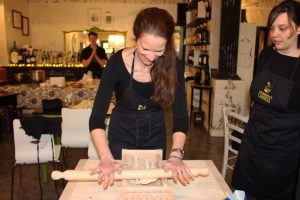 – 100g of flour to 1 egg per person. Mix it together and then stretch it out. You can’t overwork pasta dough – it’s not precious like a pastry dough – this is where you can really dig in and work the dough. Once it’s sliced, toss it with semolina and then make into two little nests.
– 100g of flour to 1 egg per person. Mix it together and then stretch it out. You can’t overwork pasta dough – it’s not precious like a pastry dough – this is where you can really dig in and work the dough. Once it’s sliced, toss it with semolina and then make into two little nests.
For me the best part of spending a day cooking with Ernesto is the obvious joy of everyone cooking together. With Ernesto, it’s all hands on deck, there’s so much to be done everyone always has something to do. And don’t worry there’s no mistake that can’t be recovered. In this kitchen, there’s no screaming or yelling, 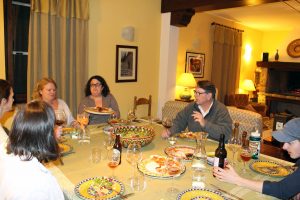 no reason to be frantic; we have the whole day together to relax and try new techniques.
no reason to be frantic; we have the whole day together to relax and try new techniques.
At the end of this exhausting day we get to enjoy the foods of our labors. And no matter the order the components were created, because of our plan the dishes are finished in order – and served with a plan: Antipasti, Primo, Secondo with Dolce at the end. Ernesto brings us no randomness, just organized chaos with a goal: enjoying an unbelievable meal together.
Ernesto teaches us multitasking Read more
I know this might shock you, but I love food and I love to eat out. However, my least favorite trend at ...
Three o’ clock is a blissful hour at Via Umbria. Late afternoon sun streams through the storefront windows, bathing the shelves in soft, golden light. Since I started writing for Via Umbria last month, this has always been my favorite time to pop downstairs and taste the scrumptious samples scattered throughout the shop: perhaps a morsel of mostaccioili by the register, or a cheddar crumble at the cheese counter. But yesterday, tantalizing aromas of bacon and freshly grated parmesan wafted from the cafe, and I had a hunch that an even greater snack lay in store.
Ernesto Parziani, chef and owner of the celebrated Umbrian restaurant Perbacco, was in the midst of a mouth-watering pasta and sauce cooking demonstration. With his week-long visit drawing to a close, I knew that this was an opportunity not to be missed.
Rolling pin in hand, Ernesto smiled and waved me over to his station, which was scattered with eggs, flour, parmesan wedges, and an array of pasta-making instruments. Water boiled next to a sizzling pan of bacon on a portable stovetop. I trotted over as Ernesto began to press a small, yellow mound of dough into the table.
I thought of the trays of delicate, ribbed tubes of Garganelli pasta that participants fashioned in his cooking class on Sunday, and wondered what was in store for this dough.
“I like to teach fresh pasta,” Ernesto told me as he rolled the mound of dough into a circle the size of a tortilla. “But you must find right consistency. If it’s too hard, it is difficult to roll. If it’s too soft, it sticks to everything.” He began to dust the dough with fine, white flour.
“My favorite dish to make is pasta. For us, in Italy, it’s like bread,” he explained, We eat it all the time, everywhere, with vegetables, with meat sauce, with fish, with eggs.” I gulped, mouth watering at the thought of such a world. Ernesto began pressing the dough into the taut steel strings of a chitarra, a guitar-like cooking instrument that Ernesto used to slice the flat yellow circle of dough into delicate strands of pasta before my eyes.
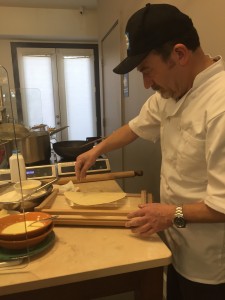
I hovered over him in awe. “How did you learn to do this?” I asked.
“It was obvious,” he shrugged. Of course. I should have known.
“When you see your mother, your grandmother make pasta three days a week, it is obvious,” Ernesto smiled. I glanced down again at the spread of ingredients, and wondered aloud about the presence of the eggs. Wasn’t pasta just … water and flour?
“In Umbria,” Ernesto explained, “we used to make pasta without eggs. Just flour and water, or perhaps one egg white without the yolk. It’s called Strangozzi.” Ernesto pried a strand of pasta from the chittara and brought it to his neck, feigning strangulation. “We eat it simply, at home, with tomato sauce.”
“You see,” he continued, “in Umbria, we started to add eggs when we began selling eggs to make money. But in the North of Italy, they have always used a lot of eggs. For example, where my wife comes from–Parma, Bologna, places in the region of Emilia-Romagna–they use a lot of yolks … and this.” Ernesto gestured towards a large bowl of white flour.
“But in the South, like Sicily, near North Africa, they make dry pasta, with semolina.” He pointed to a smaller dish of tan, coarse flour. “They make pasta, but they make couscous too. Whereas in the North, they make pasta, but also they use corn flour to make polenta.” Ernesto arranged his raw pasta into a nest on the table.
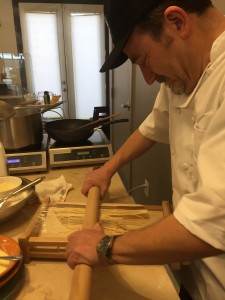
“It’s too much for one person,” he sighed.
“I could eat it all!” I exclaimed.
Ernesto shook his head. “No. Too much for one person.”
As he dropped the pasta into the boiling pot, I remembered that in Italy, pasta is just one of many courses in a meal. But before I could finish that thought, Ernesto had tossed the pasta into a pan, where he speedily sautéed it in bacon and carbonara. Suddenly, a masterpiece lay before me. My heart fluttered–even if it was “too much for one person,” no one else was there to eat it with me! But as Ernesto grated a pile of fresh parmesan onto his creation, I heard Bill’s voice ring out from across the cafe.
“We got here just in time!” he called to us, an old friend following just behind him. I sighed as Ernesto divided the spaghetti onto four plates. My glutenous, gluttonous dreams had been dashed, but that ceased to matter as soon as I took the first bite. It was absolute heaven, and once I’d cleaned my plate, I realized that Ernesto had been right. Any more than that would have been too much. I thanked him heartily, and walked back to my desk feeling sated, but not gorged. And for that, I was grateful.
-Lizzie
Pasta Making with Ernesto! Read more
Three o' clock is a blissful hour at Via Umbria. Late afternoon sun streams through the storefront windows, bathing the shelves in ...
What we loved about the end of our day: unfussy yet superb antipasti, pasta, made from start to finish in front of your very eyes, flowing wine, and dessert to die for. Dinner at Ernesto’s is served.
— Via Umbria
What we loved about the end of our day: unfussy yet superb antipasti, pasta, made from start to finish in front of your ...